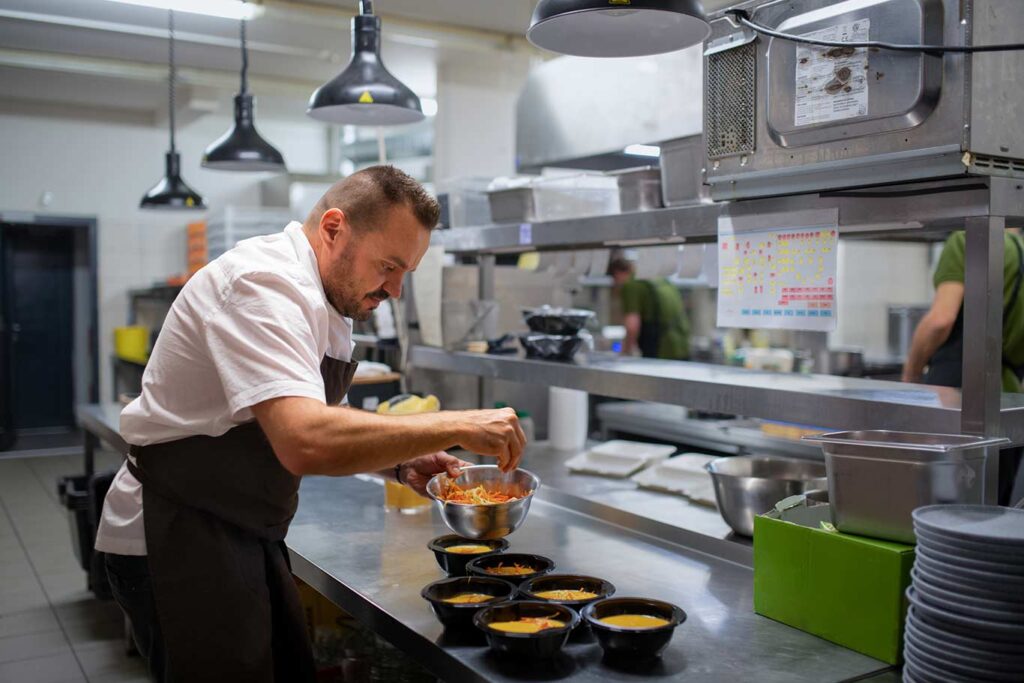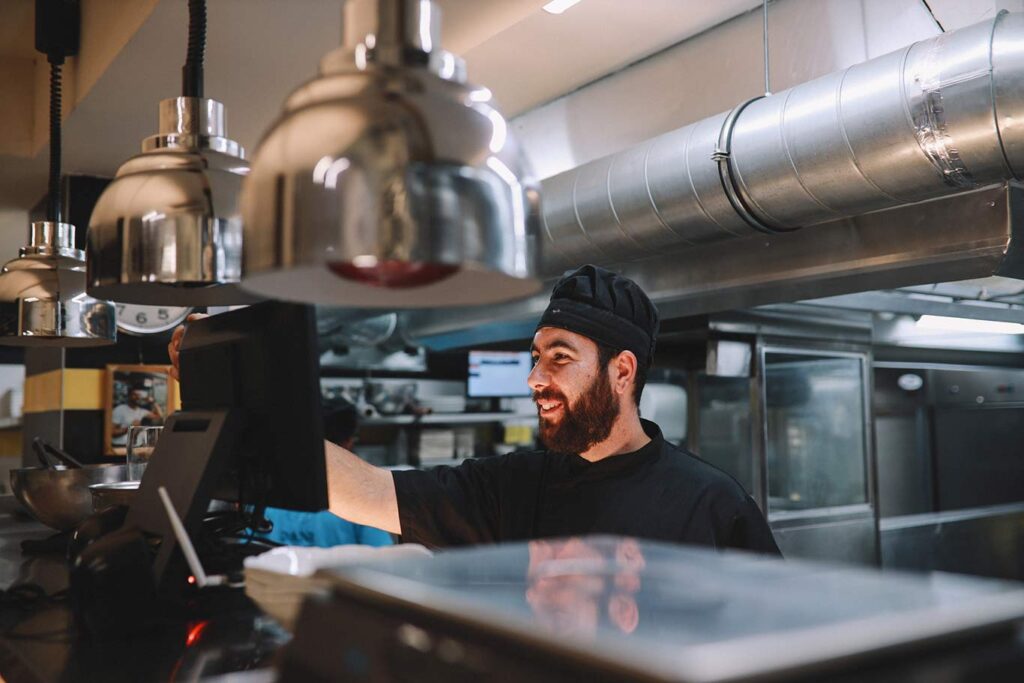Contributors
My main focus is managing the blog and product content for the Protectivity website ensuring everything aligns wi...
The food delivery industry has seen extensive growth over the past 5 years, according to reports it saw a growth rate of 6.79 % rise in CAGR, from 2017-2023. This massive growth highlights how food delivery service has become a staple in our daily lives. So, what exactly is a dark kitchen? Simply put, it’s a kitchen that operates solely for delivery or takeout, with no dine-in option. This concept is becoming increasingly relevant in today’s catering industry as more people opt for the convenience of having restaurant-quality meals delivered straight to their doorsteps.
In this blog, we’ll address what dark kitchens are, explore their benefits like cost efficiency and flexibility, tackle the challenges they face, and take a peek into future trends that could shape the food delivery landscape even further.
What is a Dark Kitchen?

A dark kitchen is a professional food preparation facility set up to produce meals exclusively for delivery. Unlike traditional restaurants, dark kitchens do not have a dining area for customers. Instead, they focus entirely on fulfilling online orders, which are then delivered to customers through various food delivery platforms.
Alternate names for a dark kitchen
Dark kitchens go by several names, each emphasising a different aspect of their unique business model.
Ghost kitchens
You might hear them referred to as ghost kitchens, highlighting their “invisible” nature, as they don’t have a public-facing presence.
Cloud kitchens
The term cloud kitchen emphasises the virtual aspect of their operations, relying heavily on technology and online orders.
Virtual kitchens
Virtual kitchens focus on the fact that their menus and brands exist primarily in the digital space, accessible to customers through apps and websites.
How They Work
The basic operational model of a dark kitchen revolves around efficiency and adaptability.
Here’s how it typically works:
Setup
Dark kitchens are located in industrial areas, warehouses, or shared commercial spaces designed to house multiple kitchen setups under one roof. These facilities are equipped with the necessary kitchen equipment to prepare a wide variety of cuisines.
Menu creation
Chefs and culinary teams develop menus tailored to delivery, ensuring that the food travels well and arrives at customers’ doorsteps in optimal condition.
Online presence
Dark kitchens operate primarily through online platforms. They list their menus on popular food delivery apps like UberEats or Deliveroo and often have their own websites for direct orders.
Processing orders
When a customer places an order online, it is routed to the relevant kitchen through a centralised order management system. This system helps streamline the process, ensuring that orders are prepared and dispatched efficiently.
Food Preparation
Skilled kitchen staff prepare the meals quickly and efficiently. Since the kitchen is optimised for delivery-only, it can focus on speed and quality without the distractions of in-house dining.
Delivery
Once the food is ready, it is handed over to delivery drivers, either from the delivery platform or an in-house team, who then transport it to the customer. Some dark kitchens also partner with third-party logistics companies to handle the delivery process.
Dark kitchens represent a significant shift in the food service industry, leveraging technology and changing consumer habits to offer a flexible and cost-effective alternative to traditional dining establishments. Whether you’re a seasoned caterer or someone looking to break into the catering business, understanding the ins and outs of dark kitchens can open up exciting new opportunities.
The Rise of Dark Kitchens

Growth of Online Food Delivery
In recent years, the online food delivery industry has experienced explosive growth, transforming how we think about dining. With the convenience of ordering meals from a smartphone app and having them delivered directly to our doorsteps, it’s no surprise that more people are opting for this service. This shift in consumer behaviour has driven a significant demand for food delivery options, paving the way for the rise of dark kitchens.
The emergence of delivery platforms like UberEats and Deliveroo has made it easier than ever for customers to explore a vast array of cuisines from the comfort of their homes. This trend has not only taken off for consumers but also for entrepreneurs and existing food businesses looking to expand their reach without the hefty investment in a traditional restaurant setup. As a result, dark kitchens have emerged as a practical and innovative solution, perfectly suited to meet the growing demand for online food delivery.
Impact of the COVID-19 Pandemic
The COVID-19 pandemic played a pivotal role in accelerating the adoption of dark kitchens. As lockdowns and social distancing measures were implemented worldwide, traditional restaurants faced unprecedented challenges.
With dine-in options severely limited, consumers turned to food delivery services in droves. The convenience and safety of having meals delivered became a critical factor for many households.
Restaurants that already had delivery capabilities could pivot more easily, while others had to quickly adapt to survive. This rapid shift in the market created fertile ground for dark kitchens to thrive.
Dark kitchens, with their focus on delivery-only operations, were uniquely positioned to meet the surge in demand. They could quickly scale up production, experiment with new menus, and serve a broader audience without the constraints of a physical dining space. This flexibility allowed them to not only survive but also flourish during the pandemic.
A new era of dining
The rise of dark kitchens signifies a new era in the dining and takeaway industry, where convenience, flexibility, and innovation are paramount. As consumer preferences continue to evolve, the dark kitchen model offers a glimpse into the future of food service. For caterers and aspiring entrepreneurs, understanding this trend is essential for staying competitive in a rapidly changing market.
Whether you’re looking to launch a new culinary venture or adapt an existing business, dark kitchens provide an exciting opportunity to capitalise on the growing demand for online food delivery. By embracing this model, you can reach more customers, optimise your operations, and navigate the challenges of the modern food industry with greater ease.
Benefits of Dark Kitchens

Cost Efficiency
Lower overhead costs compared to traditional restaurants.
No need for a physical dining space, reducing rent and utility expenses.
Minimal front-of-house staff, lowering labour costs.
Flexibility
Ability to adapt menus quickly based on customer demand.
Easy to experiment with new dishes and cuisines without the constraints of a fixed menu.
Rapid response to market trends and customer feedback.
Scalability
Easier to scale operations and expand into new markets.
Ability to set up multiple dark kitchens in different locations with relatively low investment.
Streamlined operations and centralised management facilitate growth.
Focus on Delivery
Optimised for delivery, leading to better customer satisfaction.
Enhanced food quality control tailored for delivery conditions.
Efficient order processing and quicker turnaround times for deliveries.
Challenges of Dark Kitchens
Brand Recognition
Difficulty in building a brand without a physical presence.
Limited opportunities for direct customer interaction and engagement.
Reliance on online marketing and customer reviews to establish a reputation.
Quality Control
Ensuring consistent food quality across different locations can be challenging.
Maintaining high standards for food safety and hygiene in a delivery-focused environment.
Risk of food quality dips during delivery.
Regulations
Navigating health and safety regulations can be complex.
Adherence to local food preparation and delivery standards is essential.
Potential for varying regulations across different regions or countries.
Competition
High competition in the online food delivery market.
Differentiating from other dark kitchens and traditional restaurants.
Keeping up with evolving consumer preferences and technological advancements.
Technology in Dark Kitchens

Online ordering platforms and apps are the backbone of dark kitchens. They facilitate seamless interaction between customers and kitchens, making it easy to browse menus, place orders, and make payments. Integration with popular delivery services like UberEats and Deliveroo ensures a broad reach and efficient order fulfilment.
Advanced kitchen management and automation tools streamline operations in dark kitchens. These systems help with inventory management, order tracking, and workflow optimisation. Automation reduces manual labour, minimises errors, and speeds up food preparation, ensuring timely deliveries.
Leveraging data is key to optimising operations and enhancing the customer experience in dark kitchens. Data analytics tools track customer preferences, peak ordering times, and delivery performance. Insights gained from data help in menu optimisation, targeted marketing, and improving overall service efficiency, leading to increased customer satisfaction.
Dark Kitchen Success Stories
Deliveroo
Deliveroo Editions, launched by the UK-based food delivery giant Deliveroo in 2017, exemplifies the innovative dark kitchen model. This concept allows high-quality restaurant brands to reach new areas without the need for traditional dining establishments.
Business Model
Deliveroo Editions sets up shared kitchen spaces in strategic locations, leasing them to established restaurants. This approach reduces overhead costs and financial risk for restaurants, enabling them to expand their delivery reach efficiently.
Technology Integration
Advanced kitchen management systems and integration with Deliveroo’s delivery platform streamline operations and enhance customer experience. Data analytics provide insights into customer preferences, helping optimise menus and operations.
Scalability and Flexibility
The dark kitchen model allows for rapid market expansion and adaptation to customer feedback. Restaurants can quickly modify menus based on trends, staying competitive and relevant.
Impact and Success
Deliveroo Editions has helped brands like Pizza Express and Franco Manca extend their reach across the UK. This model allows restaurants to focus on creating delicious food while managing delivery logistics efficiently.
Future Trends

Emerging Innovations
The dark kitchen space is poised for significant technological advancements. Automation and robotics are set to revolutionise food preparation and packaging, enhancing efficiency and consistency. Innovations such as AI-driven kitchen management systems will optimise inventory, reduce waste, and streamline operations. Additionally, the use of virtual reality for kitchen staff training and augmented reality for kitchen layouts will further enhance operational efficiency.
Market Predictions
Experts predict that the dark kitchen market in the UK will continue to grow rapidly, driven by increasing consumer demand for convenient food delivery options. As more restaurants adopt the dark kitchen model, we can expect a rise in hybrid models, where traditional restaurants operate both dine-in and dark kitchen services.
The integration of more sophisticated data analytics will allow for hyper-personalised customer experiences, further boosting customer satisfaction and loyalty. Moreover, the expansion of delivery-only brands and collaborations between food delivery platforms and dark kitchens will shape the future landscape.
Sustainability
Sustainability and eco-friendly practices will play a crucial role in the evolution of dark kitchens. There is a growing emphasis on reducing food waste through better inventory management and utilising surplus food donations. The adoption of biodegradable and recyclable packaging materials will become standard practice, aligning with the increasing consumer demand for environmentally responsible options.
Additionally, dark kitchens will explore energy-efficient appliances and renewable energy sources to minimise their carbon footprint. These sustainable practices will not only benefit the environment but also enhance brand reputation and appeal to eco-conscious consumers.
Get Caterers Insurance with Protectivity
Catering insurance for dark kitchen businesses is essential. It offers peace of mind and safeguards your business from unexpected financial liabilities, providing protection in case of accidents, foodborne illnesses, or product-related issues.
Protectivity’s speciality Catering Insurance offers Public Liability cover, designed to give you protection in the event of injury or property damage to a client or member of the public. There’s also Employers’ Liability for anyone looking after a team or employing subcontractors, which includes cover for illness or injury. You can opt for the Products Liability Insurance extension too, which protects you against claims over third-party products.
Get an instant quote to suit the needs of your business. If you’ve any questions, our team are on hand to help.
Get Catering Insurance from Protectivity
*Disclaimer – This blog has been created as general information and should not be taken as advice. Make sure you have the correct level of insurance for your requirements and always review policy documentation. Information is factually accurate at the time of publishing but may have become out of date.
Last updated by

















